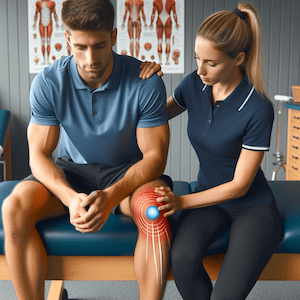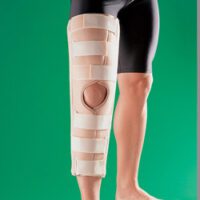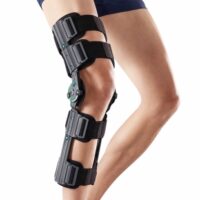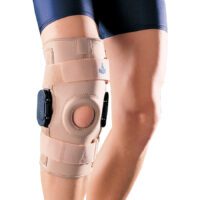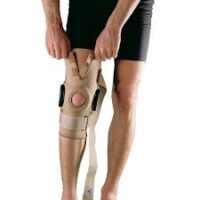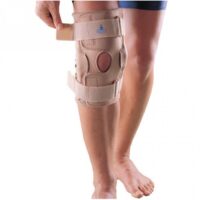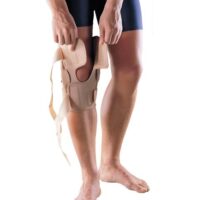
ACL Injury
A Comprehensive Guide from a Physiotherapist’s Perspective
Anterior Cruciate Ligament (ACL) injuries are among the most common and challenging knee injuries. This guide, enriched with a physiotherapist’s insights, aims to deepen your understanding of ACL injuries, including their nature, treatment options, and the vital role of rehabilitation, with an emphasis on the latest research and techniques.
What is an ACL Injury?
The ACL, a key stabiliser in the knee, often incurs injuries such as tears and ruptures. These injuries can cause severe pain, swelling, and instability, severely limiting daily activities and sports participation.
How Do ACL Injuries Occur?
Most ACL injuries in sports occur without direct contact, often during abrupt directional changes. Women are more prone to these injuries, likely due to biomechanical, strength, and hormonal differences.
Sports with High ACL Injury Risks
Contact sports like football, rugby, AFL, basketball, netball, touch, volleyball, and skiing have high ACL injury rates. These injuries can profoundly affect an athlete’s career, influencing decisions about surgery and returning to sports.
Recognising and Diagnosing ACL Injuries
Identifying Symptoms
Symptoms include intense knee pain, a ‘pop’ sound at the injury time, swelling, instability, reduced joint motion, and the knee giving way under stress. Early diagnosis is crucial for effective treatment.
Diagnosis: A Clinical Perspective
Diagnosis typically involves a physical exam and imaging tests like MRI scans. The Lachman test or pivot shift test are common physical assessments, while X-rays are less effective due to their focus on bony structures.
Treatment Approaches for ACL Injuries
Navigating Treatment Options
Treatment decisions depend on age, activity levels, and knee stability. ACL surgery isn’t always necessary. Some patients may find temporary relief as swelling reduces, but this can mask underlying instability issues.
The Role of Rehabilitation
A comprehensive ACL-Deficient Knee Rehabilitation Programme, focusing on strengthening, proprioception, and balance, is essential for those avoiding or delaying surgery. This programme is expertly guided by sports physiotherapists.
Surgical Considerations
ACL reconstruction surgery, involving tendon or ligament grafts, is common. The choice of graft depends on individual factors like age and activity level. New techniques, like double-bundle ACL reconstruction, are emerging, offering more stability. Post-operative rehabilitation is crucial for a successful recovery.
Innovations and New Research in ACL Treatment
Cross Bracing: A New Frontier
Recent studies have introduced cross bracing as a novel non-surgical treatment. This involves immobilising the injured knee at 90 degrees for 4 weeks, gradually increasing the range of motion until brace removal at 12 weeks. This method has shown promising results in promoting ACL healing, with 90% of patients showing evidence of healing on MRI three months post-rupture.
Read more:
- https://medicalxpress.com/news/2023-06-treatment-surgery-acl-rupture.html
- https://pubmed.ncbi.nlm.nih.gov/35381974/
Exercise-Based Rehabilitation: A Cornerstone of ACL Recovery
Recent evidence underscores the importance of exercise-based rehabilitation. This approach focuses on restoring knee function, enhancing muscle strength, and improving joint stability, crucial for both non-operative and post-operative patients.
Key Components of Exercise-Based Rehabilitation
Strength Training
Strengthening exercises, especially for the quadriceps and hamstrings, are vital. They enhance knee stability and support the joint, reducing re-injury risks.
Proprioception and Balance Training
Improving proprioception (the body’s ability to sense movement and position) is crucial. These exercises help patients regain control and coordination of the knee joint.
Agility and Plyometric Exercises
For athletes, agility and plyometric exercises are essential for regaining explosive power and sport-specific movements.
High-Level Balance Retraining
This involves challenging the knee joint under various conditions to improve stability and function in everyday activities and sports.
Functional Training
Tailoring exercises to mimic specific sports or daily activities ensures a safe and effective return to pre-injury levels.
The Role of Physiotherapists in ACL Rehabilitation
Physiotherapists are pivotal in designing and supervising rehabilitation programs. Their knowledge ensures exercises are performed correctly and safely, catering to the unique needs of each patient. Rehabilitation programs should be individualised, considering the injury’s severity, patient’s age, activity level, and specific goals.
Preventing ACL Injuries
Neuromuscular training, particularly for females, proper techniques, appropriate gear, and gradual intensity increases in exercises are key preventive measures. Many sport-specific prevention programs have been established. FIFA 11+ and Netball’s Knee Program are two examples.
Post-Surgical Rehabilitation
Post-surgical rehabilitation, guided by a sports physiotherapist, focuses on restoring knee function and strength. Neglecting this phase can lead to poor outcomes.
Special Considerations for Children and Return to Sports
For children, ACL surgery decisions involve assessing risks like growth disturbances. It is particularly important to seek a knee surgeon’s opinion if meniscal tears also occur at the time of injury. A comprehensive rehabilitation programme addresses both physical and psychological aspects, key to a safe return to sports. Professional guidance minimises re-injury risks.
Conclusion: The Importance of Professional Advice
An ACL injury requires careful management and informed decision-making. Physiotherapists and knee surgeons play a crucial role in treatment and rehabilitation, offering professional guidance tailored to individual needs. Consulting a physiotherapist is essential for effective recovery and a safe return to normal activities or sports. Remember, early intervention and professional advice can significantly influence your journey to recovery.
Rochedale - Call 38410277
Book Online: RochedaleSalisbury - Call 32751044
Book Online: SalisburySandgate - Call 32691122
Book Online: SandgateRelated Articles
- ACL Injury Prevention: This article discusses strategies and programs designed to reduce the risk of ACL injuries, highlighting the significant impact of prevention training on reducing injury rates.
- ACL Injury FAQs: Symptoms, Treatment, and Recovery Guide: Offers straightforward answers to common questions about ACL injuries, covering symptoms, diagnosis, treatment options, and recovery tips.
- Knee Ligament Injury – Physiotherapist Guide & Tips: Provides a broader look at knee ligament injuries, including ACL injuries, with tips on prevention, early detection, and effective treatment strategies.
- ACL Surgery: The Benefits And Risks For Informed Decisions: Explores the considerations involved in deciding whether to undergo ACL surgery, discussing the potential benefits and risks to help patients make informed choices.
- What If You Don’t Get ACL Surgery?: This article examines non-surgical approaches to managing ACL injuries, including what to expect from rehabilitation and factors to consider when deciding against surgery.
- What Is The Main Function Of The ACL?: Explains the anatomical and functional importance of the ACL in knee stability, providing foundational knowledge that underscores the significance of ACL injuries and their impact.
- Ligament Tear: Offers insights into common ligament injuries, including those affecting the ACL, and provides guidance on prevention, early detection, and treatment options.



